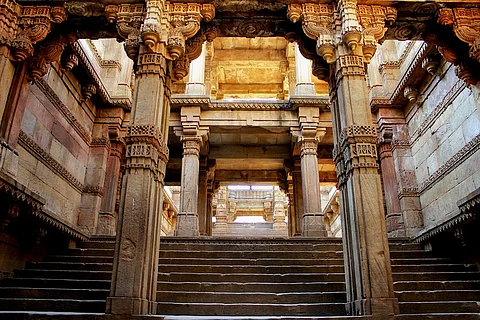
- Destinations
- Experiences
- Stay
- What's new
- Celebrating People
- Responsible Tourism
- CampaignsCampaigns
- SubscribeSubscribe
- Buy Now

Ahmedabad's old city, a UNESCO World Heritage site, is celebrated for its intricate havelis and stepwells, which exemplify the city's rich architectural and cultural heritage. Havelis are traditionally grand urban houses characterised by elaborate carvings and unique designs that reflect the artistry of their time. Each haveli typically has a distinct layout, influenced by regional styles and personal preferences.
Stepwells (known as vavs) are deep, multi-level structures that serve as water storage and gathering places. They were essential for water management and community gatherings, especially in areas with limited water resources. Here are some havelis and stepwells that you should not miss during your visit to Ahmedabad.
Mangaldas Ni Haveli I and II are now heritage hotels that provide unique accommodations in the old city. These distinctive properties offer a blend of history and modern amenities. Mangaldas Ni Haveli I is a 250-year-old wooden villa featuring two spacious suites, while Mangaldas Ni Haveli II is a 150-year-old property with a stucco façade and the Pol Kholi café. Both haveli locations are near Manek Chowk and are celebrated for combining old-world charm and contemporary comfort.
Address: Lakha Patel ni Pol, Sakdi Sheri, Khadia, Ahmedabad
Explore the captivating blend of traditional Gujarati haveli architecture and colonial influences at Jagdip Mehta's historic residence. This remarkable house, cherished by the Mehta family for over 200 years, showcases intricate woodwork that tells tales of artisanship. With its central open courtyard, or chowk, the home provides a serene gathering space filled with natural light and greenery. Visitors can also appreciate the ingenious historical water harvesting systems, highlighting sustainable practices of the past. This heritage house stands as a living museum, reflecting the region's rich cultural tapestry.
Address: Near Vanita vishram school, Motosuthar Vado, Khadia, Ahmedabad
Dodhia Haveli is a cultural gem in Ahmedabad, offering an immersive experience of the city's vibrant history. Located in the charming "pols" of the old city, this beautifully restored wooden heritage house has now transformed into a cosy hotel. The stunning facade, featuring intricate wooden carvings and colourful stained glass windows, instantly captivates visitors. Inside, the haveli blends architectural styles, creating a unique atmosphere that preserves its historical charm while providing modern comforts. Situated in a lively "pol," Dodhia Haveli is part of a close-knit community that reflects Ahmedabad's rich social and cultural life, making a stay here an unforgettable journey into the heart of the city's heritage.
Address: OPPO Goswami Haveli, Chaumukhji Ni Pol, near Vraj Swami Comlex, inside Ratan Pole, Old City, Panchkuwa, Tankshal, Khadia, Ahmedabad, Gujarat 380001
The Dayabhai Mehta Haveli, located in Desai ni Pol, is in a heritage area known for its historical houses and exquisite woodcarvings. This haveli was the residence of Dayabhai Mehta, a lawyer and Diwan (Chief Minister) of princely states. It has served as a venue for important meetings and discussions, and notable figures such as Mahatma Gandhi and Swami Vivekananda have visited.
Today, the haveli operates as a museum that showcases a collection of pre-independence artifacts and photographs, offering visitors a glimpse into the past. Its central courtyard features a distinctive three-tier water harvesting system, further enhancing its architectural significance.
Address: Old City, Khadia, Ahmedabad
The Adalaj Stepwell, situated near Ahmedabad in Gujarat, India, is a UNESCO World Heritage Site. It was included as part of the "Historic City of Ahmedabad," the first Indian city to receive UNESCO recognition. Located in the village of Adalaj, this stepwell is a remarkable example of Indian stepwell architecture, constructed in the 15th century. It is renowned for its intricate carvings and design. The stepwell consists of five levels, features three entrances, has a unique octagonal shape, and contains a 20-m deep well, serving both as a water source and a community gathering place.
Dada Harir Vav is a remarkable 15th-century stepwell notable for its Indo-Islamic architectural style, intricate carvings, and dual inscriptions in Sanskrit and Arabic. The stepwell features five levels and an octagonal shape, along with a mosque, a tomb, and sculptures of Hindu deities. Its design showcases a unique blend of Solanki and Islamic architectural elements, reflecting a rich cultural fusion. Within the stepwell complex, you can find a mosque and the tomb of Bai Harir Sultani (Dhai Harir). The presence of sculptures depicting Hindu deities highlights the syncretic nature of the art and culture of that time. Additionally, the unique spiral staircases, hewn from a single rock, are a prominent feature, providing access to the well's depths.
